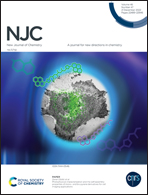Design of a paulownia-biochar/MoS2 composite electrode material for efficient electrosorption removal of Cr(vi) from wastewater
Abstract
Cr(VI) in wastewater poses a serious threat to human health, so there is an urgent need to remove it using a cost-effective way. Herein, we report a composite electrode material of homemade paulownia biochar and MoS2 (PBC@MoS2) for the efficient and selective removal of Cr(VI) from wastewater. PBC@MoS2 has an excellent ability to selectively remove Cr(VI) by electrosorption under the coexistence of different anions and cations (385.74 mg g−1 at voltage = 1.2 V, spacing = 1 mm, and initial concentration = 60 mg L−1). It can achieve 98.75% desorption and regeneration of the electrode within 1 h, and after 5 cycles of adsorption/desorption, it still maintains 97.02% of the original adsorption capacity. The characterization analysis shows that the removal process of Cr(VI) has both electrosorption and reduction effects, which can reduce 85.4% of the highly toxic Cr(VI) to the less toxic Cr(III). This is facilitated by the large specific surface area and special two-dimensional sheet structure of PBC@MoS2 composites. The results of this work can provide data support for the design of high-performance CDI systems for the removal of Cr(VI) from wastewater.



 Please wait while we load your content...
Please wait while we load your content...